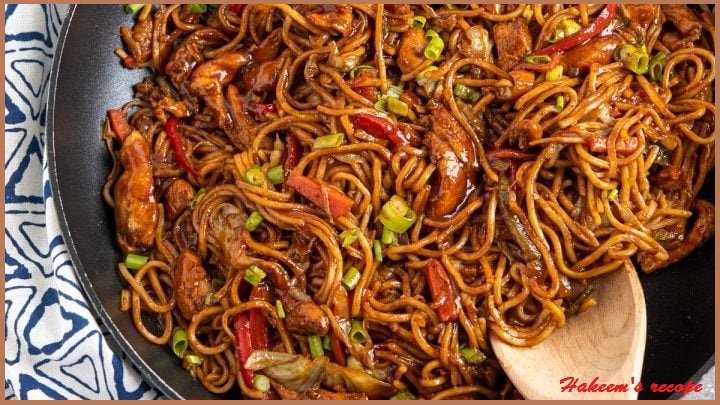Irresistible Hyderabadi Noodles
Chapter 1: Introduction to Hyderabadi Noodles
Hyderabadi noodles are a delightful fusion of Indian spices and flavors with a noodle base, making it a perfect blend of tradition and modernity. This dish, known for its spicy and aromatic profile, is a quick and easy meal that can be enjoyed as a main course or a satisfying snack. In this blog, we will explore the steps to prepare this authentic Hyderabadi recipe, ensuring you create a flavorful noodles dish that will impress your family and friends.

Chapter 2: Gathering Ingredients
To prepare Hyderabadi noodles, you will need the following ingredients:
Noodles and Main Ingredients
Noodles: 200 grams of rice noodles or egg noodles
Vegetables: 1 bell pepper, 1 carrot, 1 onion, 100 grams of green beans
Proteins (optional): 150 grams of chicken, shrimp, or tofu
Spices and Seasonings
Ginger-Garlic Paste: 2 tablespoons
Ground Spices: 1 teaspoon each of cumin, coriander, turmeric, red chili powder, and garam masala
Whole Spices: 1 bay leaf, 2 cloves, 1 cinnamon stick
Herbs: Fresh coriander leaves, curry leaves
Condiments: 2 tablespoons of soy sauce, juice of 1 lemon
Salt and Pepper: To taste
Cooking Oil: 2 tablespoons
Chapter 3: Preparation Steps
Preparing the Vegetables and Proteins
Chop the Vegetables: Slice the bell pepper, carrot, and onion into thin strips. Chop the green beans into small pieces.
Prepare the Proteins: If using chicken, cut it into thin strips. For shrimp, clean and devein them. If using tofu, dice it into cubes.
Cooking the Noodles
Boil the Noodles: In a large pot, bring water to a boil. Add a pinch of salt and the noodles. Cook according to the package instructions until they reach an al dente texture.
Drain and Rinse: Once the noodles are cooked, drain them in a colander and rinse under cold water. This halts the cooking process and helps prevent the noodles from sticking together.
Chapter 4: Cooking the Hyderabadi Noodles
Step 1: Sautéing the Spices and Aromatics
Heat the Oil: In a large pan or wok, heat the cooking oil over medium heat.
Add Whole Spices: Add the bay leaf, cloves, and cinnamon stick. Sauté for a minute until they release their aroma. Then, add the ginger-garlic paste and continue to sauté for another minute, until the raw smell dissipates.
Step 2: Cooking the Vegetables and Proteins
Add the Onions: Add the sliced onions and sauté until they turn golden brown.
Add the Vegetables: Add the bell pepper, carrots, and green beans. Stir-fry the vegetables until they are just tender but still crisp.
Cook the Proteins: If using chicken or shrimp, add them to the pan and cook until fully cooked. For tofu, gently stir it in to avoid breaking.
Step 3: Adding Spices and Sauces
Add Ground Spices: Sprinkle in the cumin, coriander, turmeric, red chili powder, and garam masala. Mix well to coat the vegetables and proteins evenly with the spices.
Add Soy Sauce: Pour in the soy sauce and mix thoroughly. This imparts a salty and umami flavor to the dish.
Seasoning: Add salt and pepper to taste.
Step 4: Combining Noodles and Final Touches
Add the Noodles: Gently add the cooked noodles to the pan. Toss everything together carefully, ensuring the noodles are well-coated with the sauce and spices.
Garnish: Add fresh coriander leaves and curry leaves. Squeeze the juice of one lemon over the noodles for a fresh, tangy finish.
Chapter 5: Serving Suggestions and Tips
Hyderabadi noodles are best enjoyed hot. You can serve them with a side of yogurt or a fresh salad to balance the spiciness. For an extra crunch, garnish with fried onions or crushed peanuts. If you prefer a less spicy version, reduce the amount of red chili powder and garam masala.

Chapter 6: Health Benefits and Variations
This dish can be made healthier by using whole wheat or vegetable noodles and reducing the amount of oil used. You can also increase the vegetable content or add more protein sources like paneer or chickpeas for a more nutritious meal. Hyderabadi noodles can be customized to suit different dietary preferences, making it a versatile dish for everyone.
Chapter 7: Frequently Asked Questions (FAQs)
Can I use different types of noodles?
Yes, you can use any type of noodles, including soba, udon, or even spaghetti, depending on your preference.
What can I use instead of soy sauce?
You can use tamari for a gluten-free option or skip it entirely for a lighter flavor.
How do I store leftovers?
Store any leftover noodles in an airtight container in the refrigerator for up to 3 days. Reheat gently on the stove or in the microwave.
Chapter 8: Conclusion
Hyderabadi noodles are a delightful dish that combines the rich and spicy flavors of Hyderabadi cuisine with the comfort of noodles. Whether you’re a fan of Indian food or just looking for a new recipe to try, this dish is sure to impress. With its quick preparation and versatile ingredients, Hyderabadi noodles make for an excellent meal option any day of the week.
Chapter 9: Tips for Enhancing the Flavor
To elevate your Hyderabadi noodles and make them even more delicious, consider the following tips:
Use Fresh Ingredients: Fresh vegetables, herbs, and spices make a significant difference in the taste and aroma of the dish. Always use fresh ginger-garlic paste and herbs for the best results.
Adjust Spice Levels: If you prefer a milder version, reduce the amount of red chili powder and garam masala. For a spicier kick, add chopped green chilies or increase the quantity of spices.
Experiment with Proteins: While chicken, shrimp, and tofu are common additions, you can experiment with other proteins like paneer, lamb, or even boiled eggs to create different variations.
Add Crunch: For extra texture, garnish the noodles with crispy fried onions, roasted peanuts, or toasted sesame seeds.
Flavor Infusion: For a deeper flavor, marinate your protein in a mixture of yogurt, spices, and lemon juice before cooking. This not only boosts the flavor but also tenderizes the meat.
Use Homemade Spice Blends: If possible, prepare your spice blends at home. Freshly ground spices have a more intense flavor compared to store-bought ones.
Include Aromatic Elements: A touch of saffron or a dash of rose water can add a unique aromatic element to your dish, making it truly special.
Chapter 10: Serving Suggestions and Pairings
Hyderabadi noodles can be enjoyed on their own or paired with a variety of accompaniments:
Raita: A cool and creamy yogurt-based raita helps balance the spice level of the noodles. Try cucumber, mint, or boondi raita.
Salad: A fresh salad with cucumbers, tomatoes, and onions provides a refreshing contrast to the rich flavors of the noodles.
Bread: Serve with naan or paratha for a more filling meal. The bread can help soak up the flavorful sauce.
Pickles and Chutneys: Indian pickles and chutneys add a tangy and spicy element to the meal, complementing the noodles perfectly.
Drinks: A traditional Indian drink like buttermilk (chaas) or lassi can cool the palate and enhance the overall dining experience.
Chapter 11: Storing and Reheating
If you have leftovers, follow these tips for storing and reheating:
Storage: Store the noodles in an airtight container in the refrigerator. They can be stored for up to 3 days.
Reheating: Reheat the noodles in a pan over medium heat. Add a splash of water or broth to keep them from drying out. You can also microwave them in a microwave-safe dish, covered with a damp paper towel to retain moisture.
Freezing: While noodles can be frozen, they may lose their texture. If you plan to freeze, do so without the vegetables, as they can become mushy when reheated. Freeze the sauce and noodles separately for the best results.
Chapter 12: Exploring Other Hyderabadi Dishes
Hyderabadi cuisine is rich and diverse, with a variety of dishes that are worth exploring:
Hyderabadi Biryani: A world-famous rice dish with layers of marinated meat, aromatic rice, and spices.
Mirchi Ka Salan: A spicy curry made with green chilies and a rich peanut-sesame sauce.
Haleem: A slow-cooked stew made with meat, lentils, and wheat, known for its rich and hearty flavor.
Hyderabadi Kheema: Spicy minced meat cooked with a blend of spices and peas, often served with naan or rice.
Exploring these dishes will give you a deeper appreciation for the complexity and richness of Hyderabadi cuisine.

Chapter 13: Frequently Asked Questions (FAQs)
Q1: Can I make this dish vegetarian or vegan?
Yes, simply omit the meat and use tofu, paneer, or a variety of vegetables as a substitute. Use plant-based soy sauce for a vegan version.
Q2: What type of noodles work best for this recipe?
Rice noodles, egg noodles, or even wheat noodles can work well. The choice depends on your preference for texture and flavor.
Q3: Can I use pre-made spice blends?
While pre-made spice blends are convenient, freshly ground spices provide a more vibrant flavor. If using store-bought blends, check for any added salt or preservatives.
Q4: How can I reduce the spiciness of the dish?
Reduce the amount of red chili powder and garam masala, and avoid adding green chilies. You can also serve the dish with yogurt to help cool down the spiciness.
Q5: What can I do if my noodles turn out too dry?
Add a bit of water, broth, or more sauce to the pan and gently toss the noodles to rehydrate them.
Chapter 14: Conclusion
Hyderabadi noodles are a perfect blend of traditional Indian flavors and a versatile noodle base, making them an excellent choice for both weeknight dinners and special occasions. With its rich spices and aromatic ingredients, this dish captures the essence of Hyderabadi cuisine while offering the convenience of a quick and easy meal. Whether you’re a seasoned cook or a beginner, this recipe is straightforward and adaptable, allowing you to experiment with flavors and ingredients.
We hope this guide helps you create a delicious and satisfying Hyderabadi noodles dish at home. Enjoy the cooking process, savor the rich flavors, and don’t hesitate to share your experience and any personal twists you add to the recipe. Happy cooking!










